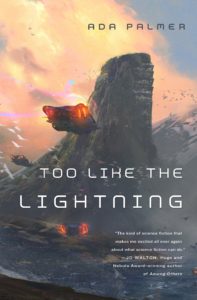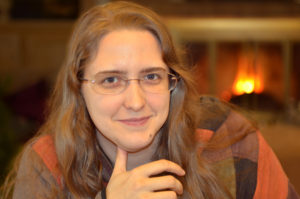Renee Ahdieh, The Crown and the Arrow. Kindle. This was a promotional short story of the sort that is the interstices between perspectives in the related novel. I’m still willing to try these, but I’m coming to the conclusion that very few of them are satisfying as short stories; they’re mostly not trying to be short stories. They’re trying to be trailers for the related novels, or author-written fanfic, basically. Short story writing and novel writing are not the same skill, and while some of the authors who are being encouraged by their publishers to put this kind of content out may very well have short story writing skills, they aren’t necessarily being encouraged to use it here. So…I am the wrong reader for this kind of content. I am more pleased by the shape of the novel staying the shape of the novel than by “deleted scene” or “extra perspective” type short content; I want a short story to be satisfying in itself. I will just wait impatiently for the next actual Renee Ahdieh book in this series.
A.S. Byatt, The Children’s Book. Reread. Oh how I love this book. Oh how I love this book. Its cast of thousands does not bother me in the slightest. It is right in my wheelhouse, all the Pre-Raphaelite and Fabian and all the different kinds of artist and their families, the places they overlap and the ways they go off the rails. It is such a lovely book, the class differences and class crossing and passing and not passing. The things Byatt does with the stresses of a world without reliable birth control, with women who just desperately, passionately, want to work, want to do something. And the ones who don’t. Possession is the canonical favorite Byatt, and I keep meaning to go back and reread that, but I don’t think it can possibly supplant this in my heart, this is meant for me, it is mine.
John Crowley, Little, Big. Reread. This is such a strange book. It’s got all sorts of women, but they seem curiously passive and interchangeable. And yet there is enough to it, enough weight of magic, that I still like it, I still like the feel of the places and the weight of things. And it is better, much better, for having read even one of Thornton Burgess’s books; the thing that was all right when read as general was much, much better as a specific reference.
Aliette de Bodard, Ships in Exile. Kindle. (Not available for purchase. -ed) A handful of stories in various settings I had seen the edges of from de Bodard before; I particularly liked the Mexica-inflected future, similarly influenced to her mystery novels but with a very, very different result.
Pamela Dean, Juniper, Gentian, and Rosemary. Reread. I keep coming around to different places every time I read this book. This time I kept thinking: I don’t know of anybody else who has even tried to talk about the adolescent balance in autonomy and protection in quite this way. I don’t even know how many people have tried to think about it nearly this carefully, even if they came to very different conclusions. I think mostly, culturally, autonomy is not a word people are encouraged to think about for persons under the age of seventeen or so, twenty-five to be safe, possibly a minimum monthly income instead.
Mark Forsyth, The Etymologicon: A Circular Stroll Through the Hidden Connections of the English Language. This was another of Forsyth’s pop etymology books, nothing particularly earth-shattering but a perfectly pleasant thing to pick up and put down when I wasn’t sure how much time I would have to read before getting on a plane and didn’t want anything with narrative throughput that I would mind interrupting.
Elena Helander-Renvall, Silde: Sami Mythic Texts and Stories. A beautifully illustrated volume purchased at the Arktikum. (And as far as I can tell available only in Finnish museums. Some of the illustrations are online. -ed) Not as large as one might like, but we take what we can get here, tales of the kinds of spirits, the kinds of dogs, the kinds of people of the far north of the Scandinavian peninsula and western Russia.
Reginald Hill, Good Morning, Midnight. Reread. Not entirely believable Dalziel backstory, I’m afraid, and not one of the more memorable late series entries. I do like Emily Dickinson. I wish Hill had done better by her. Not offensive, just not a standout.
Kameron Hurley, The Geek Feminist Revolution. Discussed elsewhere.
E.K. Johnston, Exit, Pursued by a Bear. This is a beautiful thing to do, so very much worth having. Read with care. It is not, very surely not, a Teen Problem Novel. It is the story of Hermione, a cheerleader, who goes away to cheerleading camp and is roofied and raped. It is the story of her surviving. Her aftermath. Her living on and being herself. It is the story of those who are fiercely, wonderfully there for her, and some who are not–some who don’t know how to be, some who don’t want to be. If you have ever been Hermione. If you have ever been Polly, the best friend–oh how I love Polly–with the stats, who among us has not been one or the other or both, once or twice or too many times.This book is for the Hermiones, the Pollys, the moms and the dads and the Coaches. Kate wrote it for all of us with so much love, and she wrote it for the girls who hope they never identify firsthand with anybody in it, ever, ever, because that’s the hell of YA: you write things like this hoping that they are in advance of the problems teenagers actually face, and you know that in too many cases they aren’t. Read it carefully. Choose your timing carefully. But read it, because it’s beautiful, and it’s the kind of triumphant that life is allowed to be, and it’s written with love.
Gwyneth Jones, Band of Gypsys. Reread. This is act four of a five-act structure, and everything goes all to hell, as you would expect, geopolitically and interpersonally. I do love this series still, and it is worth not skipping this on the reread, but while the others can be grim, this is more of a grim slog, and also there are fertility issues that may be difficult in multiple directions, be aware if you’re considering it.
Kim MacQuarrie, The Last Days of the Incas. Large and moderately informative book about what it says on the tin.
Hilary McKay, Casson Family: Rose’s Blog. Kindle. Very short and very light, does not cohere as a story. Much though I like getting more Cassons, this felt more like “no, really you’re not getting more Cassons” rather than like actually more Cassons. It trickled off in the end in a not very satisfying way. It was meant as promotional material. Repeating theme: I am not the audience for promotional material really.
William Morris, The Wood Beyond the World. Kindle. Oh how I love William Morris…as a designer of wallpapers and ceramic tiles. As an overwrought fabulist mumbling about which women are the scheming evil women with scheming evil dwarves? OH UNCLE WILL NOT REALLY NO. Go look at pictures of the ceramic tiles instead, really. That will be best. The title is the best thing in this book. No wonder CS Lewis wanted to do something better with it.
Ada Palmer, Too Like the Lightning. Discussed elsewhere.
Johan Reinhard, The Ice Maiden: Inca Mummies, Mountain Gods, and Sacred Sites in the Andes. Do you think that Johan Reinhard is the most interesting person in the world? Do you expect that he has been right in every conversation that he’s had, and probably has been ill done by in most interactions? If not, this book will probably annoy you considerably. The mummy in question is interesting. The bits where he is actually talking about how she was found: pretty interesting. All the bits that are pompous overwrought not-really-memoir: eh. Also there was much more room for information about. Well. The Inca Empire. Which interested me more than Johan Reinhard did, before I knew anything about Johan Reinhard, and now that I have read this book and learned more about him: even more so.
Ranylt Richildis, ed., Lackington’s Issue 9. Kindle. I hate it when friends of mine have the clear-cut most interesting story in an issue of something, because then I feel like I’m being biased and fond. But Arkady Martine’s ‘Contra Gravitatem (Vita Genevievis)’ was the clear standout; it drew on Martine’s scholarly knowledge and Silver Age SF for a satisfying modern story.
John Ruskin, The Two Paths. Kindle. This took me months to read. Months. Because every time I would to go read it, I would curse at John Ruskin and put it back down again. Finally I was on the train to Falun and gritted my teeth so that I could go on to read other things that were not bloody bloody John Ruskin. He enumerates in this, for example, how it is that we can know that Scottish art is superior to Indian art. Yes, how is it that we can know a thing that is not true as a generalization? Tell us, John Ruskin! Having read it, I can tell you: he is making racist bullshit 19th century claims. One of my friends upon hearing me complain started condescending to me about how philosophy can be hard if you don’t have the background. Begging pardon, I do have the background. And with the background, it can be quite easy to see when someone is using the language of aesthetic philosophy to back up the racist claim that made them most comfortable, that they had arrived at before they started. There was no chance that the pure spirit of philosophic inquiry was going to lead John Ruskin to the idea that Scottish art might be inferior to that of anybody brown. Or that, God forbid, art should be judged on a case by case basis rather than nationally. So. This was useful in the “what kind of crap would people in particular situations have been fed and what kind of crap would somewhat later people be reacting against” research. I do not commend it otherwise.
Sherwood Smith, Commando Bats. Kindle. Older ladies wrestle with newly granted magic powers. Hijinks ensue. I could do with more hijinks from this crew whenever Sherwood wanted.
G. Willow Wilson, Ms. Marvel: Crushed. I was disappointed in this volume compared to the previous two. The plot felt incredibly paint-by-numbers and canned. I hope that it was just a move to get the plot to a more interesting place. I’ve heartily enjoyed what Wilson has done so far, so I’m willing to keep going, and it’s not like this was in any way upsetting or offensive. Just: meh.

